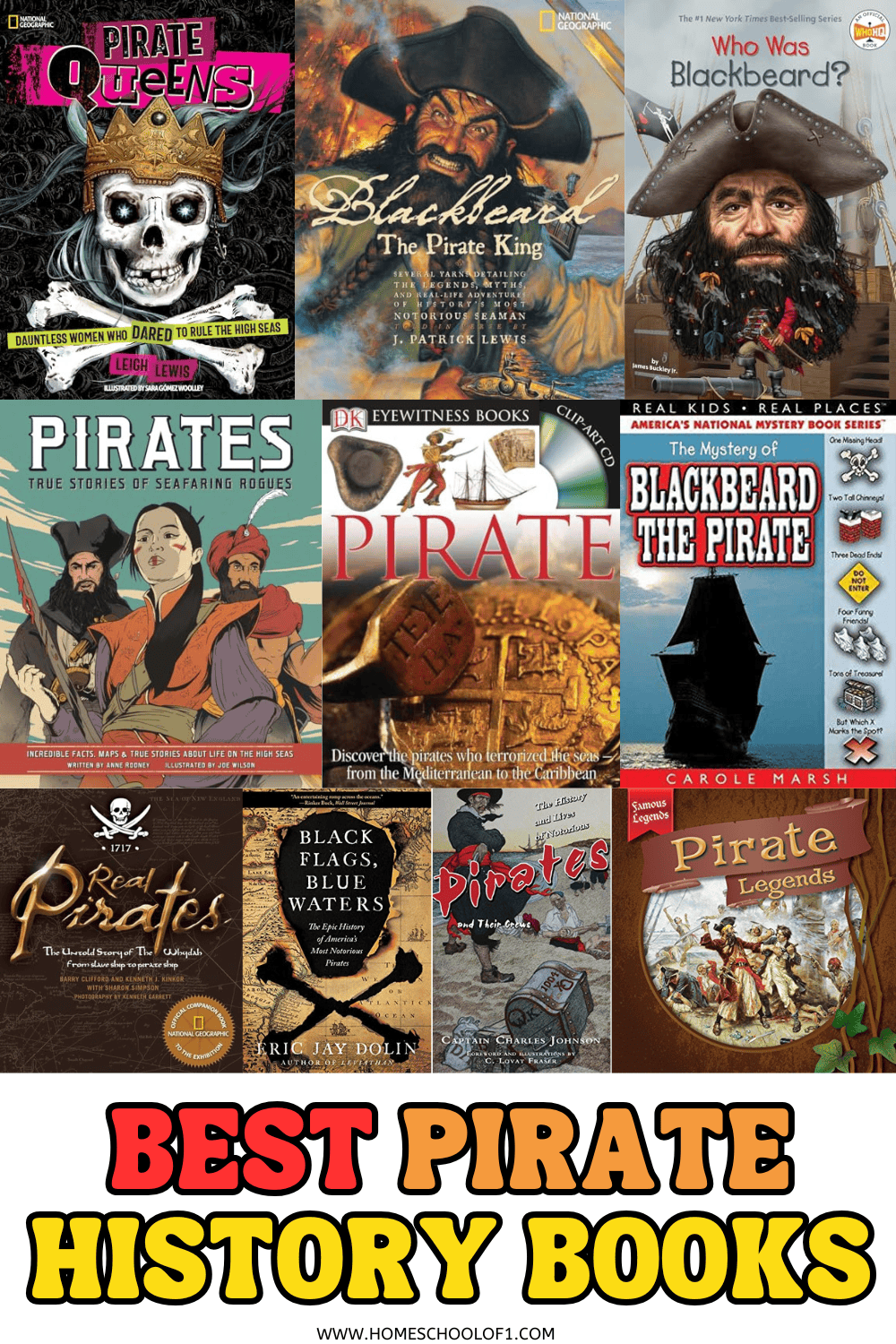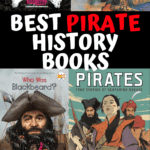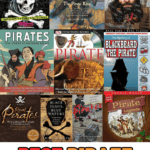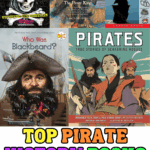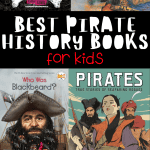Pirate history books ended up being one of the most unexpected hits in our homeschool.
What started as a quick interest in treasure maps turned into weeks of reading about real pirates, how they lived, and the wild stories behind their legends.
For my son, these books made history feel less like a lesson and more like an adventure.
From dramatic sea battles to the lives of pirate queens, we found ourselves constantly asking, “Did that really happen?”
**This post may contain affiliate links. As an Amazon Associate and a participant in other affiliate programs, I earn a commission on qualifying purchases.**
Books That Brought Pirate History to Life for Us
There’s something about real pirate stories that completely hooked my son, from the wild adventures to the gritty truth behind the legends.
These pirate history books turned into more than just a fun reading list; they gave us weeks of deep dives into maritime battles, famous ships, and the people who became legends at sea.
Some names, like Blackbeard and Ching Shih, came up again and again in our house. Others sparked questions we hadn’t thought to ask, like what life was really like on board a pirate ship, or how women like Anne Bonny fought their way into the history books.
If your kids are anything like mine, these titles won’t just teach them history—they’ll make it stick.
Pirates Fact Tracker
This Magic Tree House companion book was a favorite in our house when my son wanted to know if Jack and Annie’s adventures were based on anything real. It covers pirate ships, daily life, and even famous names in a way that's easy to digest but still packed with information. It’s a great starter for curious readers who want facts without feeling like they’re reading a textbook.
Read More
The Mystery of Blackbeard the Pirate
We used this during a history unit, and it sparked so many questions about North Carolina’s coast and the real Blackbeard. It blends historical facts with fiction in a way that feels like solving a mystery—which really works for kids who love puzzles and suspense. Bonus: It pairs well with a map activity or timeline project.Carry on learning with our famous pirates coloring pages.
Read More
Pirates’ Gold
This time-traveling middle grade book is more imaginative but still grounded in historical facts. It worked well when we wanted something fun but not completely made up. If your child enjoys adventure stories with a bit of history woven in, this one adds a creative twist while touching on real pirate legends and locations.
Read More
Blackbeard the Pirate King
This one’s for kids who enjoy poetry—or for parents who want to sneak some poetry into pirate studies. The illustrations are bold and vivid, and the poems are short enough to hold attention while still telling Blackbeard’s story. It led to a great discussion in our house about how storytelling styles affect how we understand history.
Read More
Pirate
We always turn to DK books when we want big visuals and lots of bite-sized facts—and this one didn’t disappoint. It’s loaded with labeled diagrams, ship layouts, and photos of artifacts that really helped us picture what pirate life looked like. It’s ideal for visual learners or kids who like flipping through rather than reading cover to cover.Have fun with our free pirate writing prompts too!
Read More
True Stories of Historical Pirates
This book felt like a step up for older readers—more detail, more grit, but still written in a way that’s accessible. My son was especially interested in how some of these pirates operated more like war strategists than treasure hunters. It works well if your child is ready for a more realistic, less glamorized view of pirate history.
Pirate Queens
We added this one to balance all the Blackbeard-heavy material. The poetry format is unexpected but works beautifully, especially with the vibrant illustrations. Ching Shih’s story stood out most—commanding a fleet larger than most navies blew our minds. This is a strong choice for introducing powerful women in history, especially those who aren’t often covered in traditional history books.
Pirates
This was one we grabbed for a casual afternoon read, but we ended up using it as a reference multiple times. It’s straightforward, fact-filled, and a bit lighter than some of the others. Great for kids who want pirate facts without a long narrative—think of it as a pirate encyclopedia, but with kid-friendly energy.
Read More
Pirate Ship
If your child is obsessed with how things work (mine is), this book is a win. It breaks down every part of a pirate ship and walks readers through daily life aboard. It led to hours of LEGO ship-building and sketching designs based on the book's diagrams. Definitely one of the most interactive reads we’ve had in this category.
Read More
Real Pirates
This one felt heavier, both in topic and tone—but it’s incredibly powerful. It gave us a real look at the connection between piracy and the transatlantic slave trade, something that doesn’t come up in most kid-friendly pirate books. The photos and archaeological details made it feel like we were uncovering something real. Best for older tweens and teens who can handle deeper discussions.Have fun pretending to be a pirate with our free if I were a pirate writing prompt.
Read More
Who Was Blackbeard?
This is part of the classic “Who Was?” series, and it’s probably the most approachable biography we’ve found on Blackbeard. My son read it in one sitting and kept repeating wild facts for days. If your child already likes this series, this one’s a no-brainer—and it works great as a lead-in to more detailed pirate history.
Read More
A General History of the Pirates
We treated this like a reference book more than a sit-down read. It’s not written for kids, but older teens with a strong interest in history can definitely handle it. What’s fascinating is how much of our modern pirate myths come from this book—it’s basically the origin of pirate storytelling. We used excerpts and compared them with other sources, which made for a great critical thinking exercise.
Pirates: True Stories of Seafaring Rogues
We liked how this one reads like short adventure stories but keeps everything rooted in fact. It’s one of those books you can read in bits—perfect for bedtime or morning basket time. The illustrations are dramatic and engaging, and the mix of well-known and lesser-known pirates keeps things fresh.
Read More
The Whydah: A Pirate Ship Feared, Wrecked, and Found
This book brought the story of the Whydah to life in a way that felt almost cinematic. It takes readers through the ship’s history, its wreck, and the discovery of its treasure centuries later. We followed it up with a mini-research project using museum websites and news clips. A great one for kids interested in archaeology and real-world discoveries.Add this book to these pirate activities for middle schoolers.
Read More
If a Pirate I Must Be: The True Story of Black Bart
This was one of the more in-depth reads we explored when my son wanted to know about pirates beyond just Blackbeard. Black Bart’s story is packed with action, and the biography reads like a novel—fast-paced but full of real history. It’s better suited for older kids or teens who can stick with a longer narrative and are ready for a more nuanced take on piracy.
Read More
Pirate Queens: The Lives of Anne Bonny & Mary Read
This one helped fill in the gaps after we read about Ching Shih and wanted more stories about women pirates. It digs into Anne and Mary’s partnership, and what made their lives so extraordinary for the time. It sparked a lot of discussion in our house about gender roles and how history tends to gloss over figures like them. Definitely worth reading together and talking through.
Lives of the Pirates: Swashbucklers, Scoundrels
This is a fun one—quirky illustrations, short bios, and just enough weird facts to keep kids hooked. We kept coming back to it for quick reads, especially when we wanted to compare different pirates’ backgrounds and motives. It’s great if your child enjoys reading about people more than events or battles.
Read More
A General History of the Pyrates
Yes, this is the same author as the earlier “General History,” and yes—it shows up twice in the list for good reason. Some versions are better formatted for modern readers. If you’ve got a teen who’s doing a pirate research project or writing a paper, this can be a strong primary source (with a little parent guidance). We used parts of it to check how pirate stories have changed over time.
Read More
Pirate Legends
We read this one more casually, and it worked well as a kind of storybook for older kids. Each chapter is a quick read, focusing on individual pirates and their larger-than-life reputations. If your child enjoys dramatic tales and isn’t ready for full nonfiction texts, this is a nice in-between.
Read More
The History and Lives of Notorious Pirates and Their Crews
This title looks textbook-ish at first glance, but the content is digestible and well-organized. We didn’t read it straight through, but it was great for looking up specific pirates or events when we wanted more context. It also helped build a clearer picture of pirate crews—not just the captains.
Read More
Black Flags, Blue Waters: The Epic History of America’s Most Notorious Pirates
This is one of the most comprehensive reads on this list and probably the best for teens who are serious about U.S. history or piracy in early America. We used it alongside a history timeline and map work to trace how piracy impacted the colonies. There’s a lot packed into it, but it’s rewarding if your reader is up for the challenge. Whether your child is reading for fun, researching a pirate-themed project, or celebrating Talk Like a Pirate Day, these books offer a perfect mix of history and adventure. Pair them with our pirate printables to make the most of your pirate learning journey.
Last Updated on 7 April 2025 by Clare Brown
